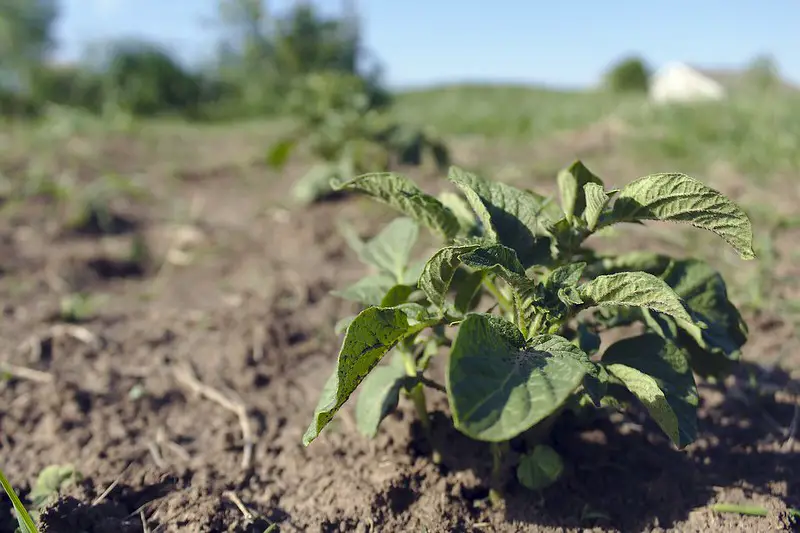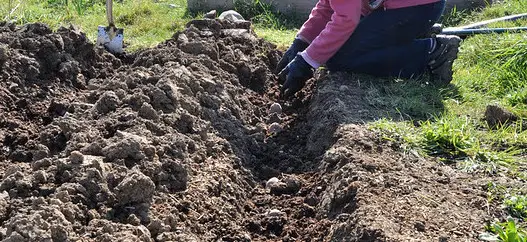We use affiliate links to run our site. When you buy through links on our site, we may earn an affiliate commission, without any added cost to you. Learn more
When planting potatoes in the ground, you want to make sure the potatoes grow well and there are no diseases. It’s not hard to plant potatoes, but there are some things you need to do.
This blog post is all about how to plant potatoes and grow them well. If you need more information about growing potatoes see our other posts on potato growing.
Which Potato Variety Should I Grow:
The first thing you should do in potato planting is to choose the right potato variety to grow. Select the variety that you are most comfortable growing.
Each potato variety varies in size, shape, skin color, flesh color, yield, cooking characteristics, time of maturity, susceptibility to disease, and sprouting ability. White, red, and russet potatoes all have their own unique qualities.
White potatoes are high in starch content, so they tend to be fluffy when cooked.
Red potatoes are low in starch content but high in moisture and sugar, making them great for potato salads and baking.
Russets are the kind most associated with boiling and mashing. They are low in vitamin C but high in starch content.
If the maturity date is your main concern for selecting a potato variety then here are some early, midseason, and late-maturing potato varieties.
Some of the Early-Maturing potato Varieties are
- Norland, Dark Red Norland
- Norgold Russet
- Russet Norkotah
- White Rose
Popular Mid-Season potato varieties are
- Kennebec
- Red LaSoda
- Red Pontiac:
Late-Maturing potato varieties
- Russet Burbank
- Century Russet
- Ranger Russet
Some popular Gourmet varieties are
- Purple-skinned varieties
- Yellow-Skins and Flesh
- Red Skin, Yellow Flesh
Choose the one that is right for you.
How to Plant Potatoes
Select A Site For Your Potatoes
Potato plants are hearty perennials that thrive in the spring and summer sun.
Potato plants should be planted in full sun, with at least six hours of sunlight each day. Give the plants room to grow so they don’t crowd each other—plant them in rows 3 feet apart.

When To Plant Potatoes:
Potatoes need cool weather to grow. So, the ideal planting season depends on where you live. So if you live in relatively cooler areas one of the first things you’ll plant in spring should be potatoes, weeks before the last frost.
Grow Potatoes From Seed Potatoes:
For more consistent results, start growing potatoes from seed potatoes. Alternatively, you can also prepare the tubers for planting potatoes. Before planting the tubers, make them sprout first.
Dig a Trench in Your Garden For The Seed Potatoes
Trenching is the easiest way to grow tubers at home. Potato trenches are not necessary for growing tubers, but they should help streamline the process and increase your harvest.
The additional soil dug out of the trench can help keep the seed potatoes moist during early development, and as the plant matures it will help grow more roots.
Preparing The Soil To Plant Potatoes
To create a good seedbed for potatoes, break up clods and remove rocks or debris by working the soil with a rake or shovel up to a level of 6-8 inches. Don’t do it too much. Excessive tillage actually can cause the soil to seal over after heavy rains, leading to seed piece suffocation and death.
The best way to increase organic matter and long-term fertility in your soil are to add amendments such as composted organic materials. These improve the structure of the soil and make it more productive. You can read more about potato soil preparation in this post.
Plant The Seed Potatoes in The Trench:
Now plant the seed potatoes in furrows and cover them with about 4 inches of soil.
Potato Plant Spacing:
How far apart you should plant potatoes depends on your potato variety and the type of gardening. Simply put potato varieties that produce large-sized potatoes like russet need a lot of space to grow compared to a small-sized potato variety like Yukon Gold.
Similarly, if you grow potatoes in the backyard the space between potato plants will be different than when you grow potatoes in a bag or bucket.
For traditional growing methods like growing potatoes in the backyards, the space between two potatoes should be 10 -12 inches. If you are growing large-sized potatoes, increase this gap to 15 inches.
If you are growing plants in a square foot gardening method uses only one potato plant per square. This way they will effectively have a gap of 12 inches between two potato plants.
And finally, if you are growing potatoes in grow bags like these plant only one or two seed potatoes. So that the plant has enough space to grow and produce a good harvest.
Taking Care of Your Potato Plants:
The potato is a root crop, and like all root crops, they need a good amount of water. When potatoes are growing, keep the soil moist but not wet. Water before the soil dries out.
Always mulch your potatoes. Mulching helps conserve soil moisture, keep weeds down, reduce soil temperatures, control pests, and retain some soil moisture through the summer.
Make sure to space potatoes at least 2 feet apart. Use boards between rows to avoid walking on soil.
Protect maturing tubers from sunlight by hilling up soil over plants with a garden rake or shovel. Be careful when digging around your potato plants.
Can You Plant Potatoes In Containers:
There’s more than one way to grow potato plants, but some methods are better than others. It all depends on your garden space, soil, time, and weather conditions.
Planting Potatoes on the ground has a lot of benefits. These advantages include a bigger harvest, a better taste, and above-ground storage. However, if you have limited space or limited time for gardening, you can opt for growing potatoes in containers.
Fill the container with 5-10 gallons of fresh water after 3 days. Then take four to six eyes of the potato. Place the eyes in the middle of the potting mixture. Put enough soil mixture around it to ensure that the potato gets maximum sunlight.
Contrary to popular belief, potatoes are not only grown in huge fields. You can easily grow potatoes in any large container (5-10 gallons) like large round pots, drums, buckets, boxes, grow bags, or gunny bags. Larger the container, the better the results.
Fill ⅓ rd of the container with a good potting mix. Plant 5-6 seed potatoes at the base, cover the potatoes with more potting mixture & water them.
Conclusion:
Don’t let the chance to grow potatoes pass you by this year. From tiny new potatoes to giant main-course spuds, growing fresh potato tubers are a delight that you can’t get from a store. Plant a few now and enjoy a bountiful harvest in a few months.
Amazon and the Amazon logo are trademarks of Amazon.com, Inc, or its affiliates.

Hi there! My name is Prasenjit and I’m an avid gardener and someone who has grown a passion for growing plants. From my hands-on experience, I have learned what works and what doesn’t. Here I share everything I have learned.
